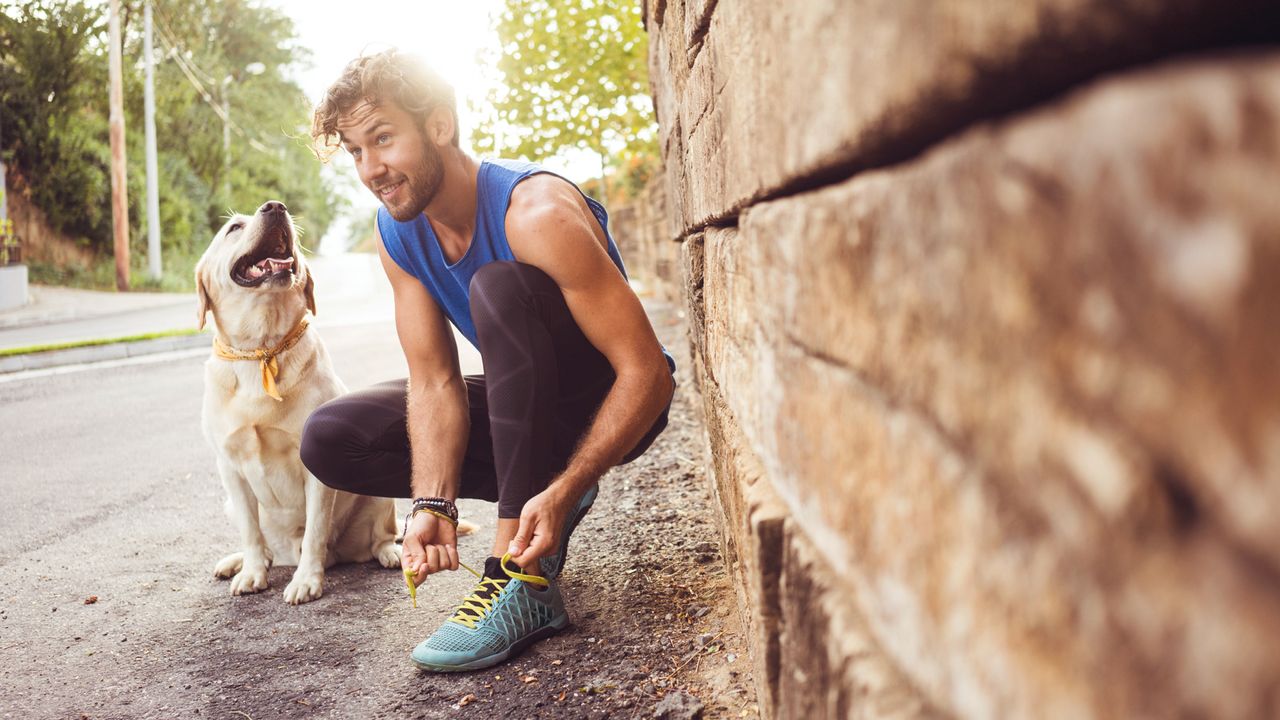Experts share top tips for working out with your dog
When you purchase through links on our site, we may earn an affiliate commission.Here’s how it works.
(Image credit: Getty Images)

(Image credit: Getty Images)
Unlike during the colder months, when people only go outside if absolutely necessary, now that the warm weather is here (kind of), more runners will consider spending more time outdoors with their pets, primarily dogs. However, before you put the leash on your border collie and drag them out for a tempo session, you should take into account the below expert tips.
Although it may seem like a great way to add an extra element of fun to our workouts, it’s important to consider animal welfare and safety before getting your pets involved, particularly if you’ve not participated in this sort of activity before.
Those looking to get in some extra bonding time with their four-legged friend, Ian Scarrott, Running Coach and Personal Trainer atPureGym, and Emma Lee, Nutrition Expert atBurns Pet Nutrition, have put together some top tips for safely working out with your dog.
It doesn’t take too much to get started, but it’s important to consider your pet’s specific requirements – are they already fit and healthy? How often should they be participating in this activity?
But before you head out for a run, consider upgrading your running gear with the help of T3’s expert running guides: check out thebest running shoes,best trail running shoesandbest running watchguides.
Ian Scarrott: “Some dogs are more suited to intervals; others may love a long-distance run”
What kind of running tempo to go with depends on the breed you have, as well as their individual preferences: “Some dogs may be more suited to intervals of short sharp bursts of speed, others may love a long-distance run”' he adds.
Sign up to the T3 newsletter for smarter living straight to your inbox
Get all the latest news, reviews, deals and buying guides on gorgeous tech, home and active products from the T3 experts
Ian has three pieces of advice and suggestions you should consider:
(Image credit: Future)

(Image credit: Future)
“Working out with a pet can also help to increase your motivation”, Ian says, “Your animal requires a walk so why not add in more intense exercise, it can certainly help you increase your activity levels and help you maintain a level of accountability in your training.”
Emma Lee: “Dogs are susceptible to similar types of skeletal and muscle injury that we are”
“Taking part in a sport with your dog can be beneficial for your furry family member and should be encouraged more often", Emma says, “It helps to increase and maintain fitness and physical/mental health and can also strengthen the bond between caretaker and pet.”
But is it only dogs that can benefit from this? Research suggests not. For example, astudyfound that fish can recognise and form attachments with their primary caregivers. “Move your workout in front of the fish tank!” Emma suggests.
“If you lack the motivation to keep up with your fitness routine, why not mix it up and try including your pet in action”, she adds, “Take it slow at first to make sure they’re comfortable with the activity, eat and drink sufficiently, and enjoy this unique bonding experience that both you and your pet are bound to enjoy.”
Emma recommends considering the following:
1. What’s your dog’s breed?
Potentially any healthy dog can be trained to run with people. There are, however, some considerations that must be made when deciding to start any sport with your dog.
“Caution must be taken with brachycephalic (flat-faced) breeds”, Emma warns people, “These dogs often have problems with breathing and will struggle in the hotter weather as they are not able to cool down effectively. Being able to lose heat will also be an issue for some of the double-coated or heavier-coated breeds such as Siberian Huskies.”
She says that some breeds are more prone to orthopaedic issues and should be treated with caution. Dachshunds, for example, are genetically prone to IVDD (disc disease), and a lot of larger breeds may be more predisposed to conditions such as hip dysplasia.
2. How fit is your pet?
Emma suggests that many dogs will need their fitness built up, much like humans. You must also consider the terrain; running is a high-impact sport, so take care when running on firm ground. Also, be careful on uneven terrain.
“Dogs will be susceptible to similar skeletal and muscle injury types that we are!” she adds, “Make sure you watch for signs of pain or discomfort in your dog when you run. You must also allow your dog time to warm up and cool down. There are many stretches and exercises that you can get your dog to do that will help with reducing the likelihood of injury.”
(Image credit: Brendan Church on Unsplash)

(Image credit: Brendan Church on Unsplash)
3. Monitor food and drink
Emma advises you to feed your dog at least one hour before exercise, ideally earlier than that, to give them enough time to digest the food. She recommends feeding two hours before and not feeding for two hours after exercise: “If you try to feed your dog too much, or too close to active exercise, this can lead to issues such as bloating.”
Hydration is also essential, particularly in warmer weather. “A loss of just 7% of your dog’s body water can lead to severe dehydration, and a 15% loss can be fatal”, she adds, “It is important to remember not to let them drink too much in one go, however, make sure they rehydrate steadily rather than drinking too much, too fast.”

Vollebak pushes the limits of outerwear with Double Graphene Puffer and Shielding SuitThe company continues to weave innovation into every thread
The company continues to weave innovation into every thread

Bowers & Wilkins Pi6 review: sensational sound, ordinary ANCBowers & Wilkins' step-down true wireless earbuds sound amazing and are well-priced – so what’s the catch, if anything?
Bowers & Wilkins' step-down true wireless earbuds sound amazing and are well-priced – so what’s the catch, if anything?